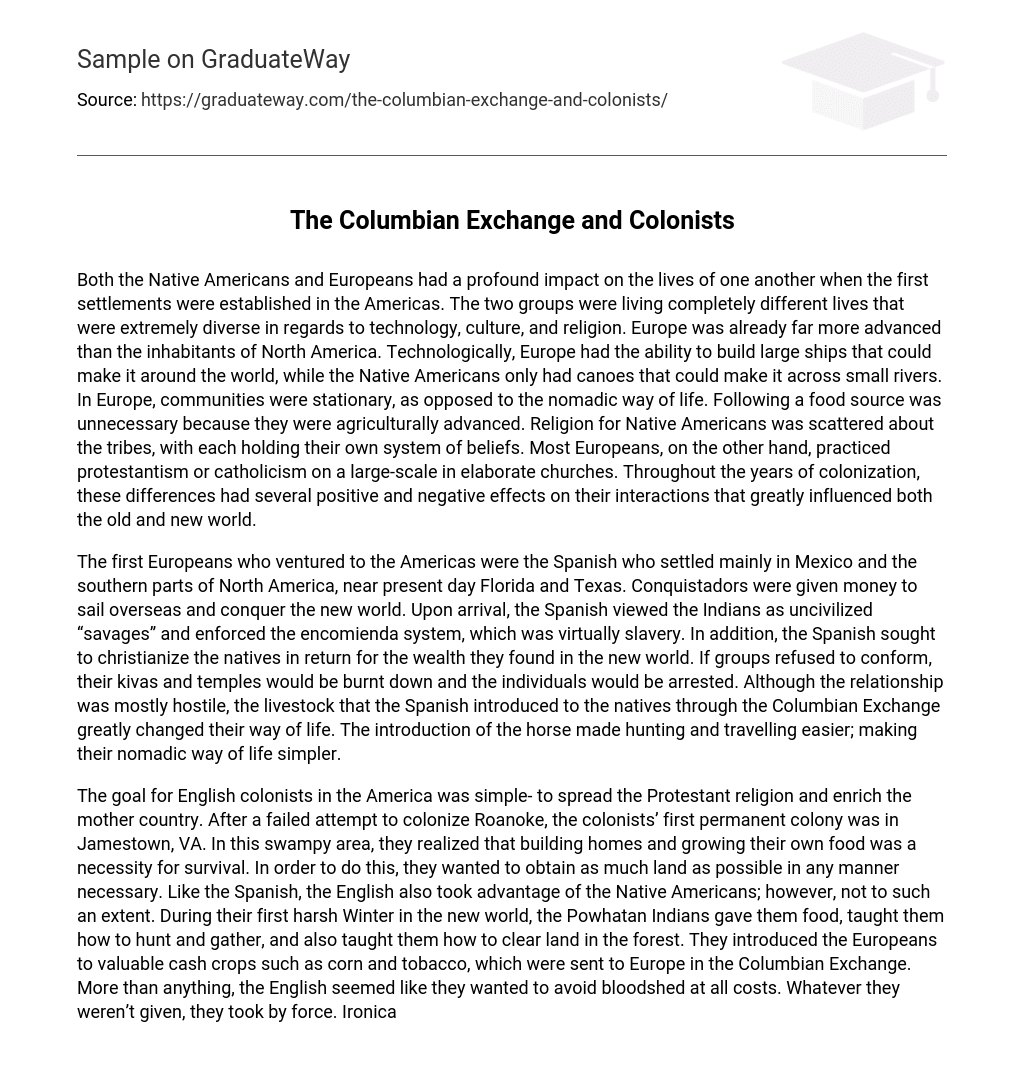Both the Native Americans and Europeans had a profound impact on the lives of one another when the first settlements were established in the Americas. The two groups were living completely different lives that were extremely diverse in regards to technology, culture, and religion. Europe was already far more advanced than the inhabitants of North America. Technologically, Europe had the ability to build large ships that could make it around the world, while the Native Americans only had canoes that could make it across small rivers. In Europe, communities were stationary, as opposed to the nomadic way of life. Following a food source was unnecessary because they were agriculturally advanced. Religion for Native Americans was scattered about the tribes, with each holding their own system of beliefs. Most Europeans, on the other hand, practiced protestantism or catholicism on a large-scale in elaborate churches. Throughout the years of colonization, these differences had several positive and negative effects on their interactions that greatly influenced both the old and new world.
The first Europeans who ventured to the Americas were the Spanish who settled mainly in Mexico and the southern parts of North America, near present day Florida and Texas. Conquistadors were given money to sail overseas and conquer the new world. Upon arrival, the Spanish viewed the Indians as uncivilized “savages” and enforced the encomienda system, which was virtually slavery. In addition, the Spanish sought to christianize the natives in return for the wealth they found in the new world. If groups refused to conform, their kivas and temples would be burnt down and the individuals would be arrested. Although the relationship was mostly hostile, the livestock that the Spanish introduced to the natives through the Columbian Exchange greatly changed their way of life. The introduction of the horse made hunting and travelling easier; making their nomadic way of life simpler.
The goal for English colonists in the America was simple- to spread the Protestant religion and enrich the mother country. After a failed attempt to colonize Roanoke, the colonists’ first permanent colony was in Jamestown, VA. In this swampy area, they realized that building homes and growing their own food was a necessity for survival. In order to do this, they wanted to obtain as much land as possible in any manner necessary. Like the Spanish, the English also took advantage of the Native Americans; however, not to such an extent. During their first harsh Winter in the new world, the Powhatan Indians gave them food, taught them how to hunt and gather, and also taught them how to clear land in the forest. They introduced the Europeans to valuable cash crops such as corn and tobacco, which were sent to Europe in the Columbian Exchange. More than anything, the English seemed like they wanted to avoid bloodshed at all costs. Whatever they weren’t given, they took by force. Ironically, the English colonists marched into Indian villages on several occasions and beheaded anyone who stood in their way. As revenge, the Powhatans launched several ambush attacks on the English that wiped out entire villages.
Out of all European groups, the French had the strongest relationship with the Native Americans. They settled in the northernmost part of the continent near present day Michigan, New York, and Quebec. In the 1600s, fur had become extremely valuable in Europe. The Indians were very skilled in obtaining fur pelts from wildlife they hunted; this is what mainly attracted the French to trade with them. Unlike the English and Spanish, French traders viewed the Indians as a necessity for survival. Without a strong relationship, they risked not being traded with. It wasn’t unordinary for the French to intermarry and reproduce with the Indians in communities they traded with. The French also formed strong military alliances with the Algonquian Indians when the English colonies kept infringing on other territories.
The impact Europeans had on Native Americans and vice-versa can not be understated. The impacts on the Natives were both positive and negative. Positively, Europe, through the Columbian Exchange, sent horses, crops, and livestock that all played an important role in Native Americans’ lives post-Europe expansion. Also, The French were by far the friendliest to them, often trading furs with them. Negatively, Europe inadvertently spread disease, also through the Columbian Exchange, across several tribes that decimated them, such as measles and smallpox. Furthermore, the Natives were subjected to slavery by the Spanish conquistadors who were money and power hungry, and Spanish missionaries who believed these “savages” could be christianized. The English, while they did not enslave them, did not treat them well, as they’d force them off their land because of their colonization goals. Despite the hardships along the way due to cultural diversity, this is how the Americas became inhabited. Though times were hard and lives were lost, new ideas and innovations made their way across the globe which paved the way for the development of a new and improved world.





